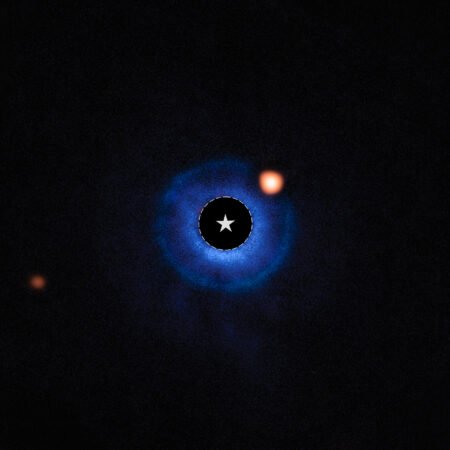Essential Insights
-
Discovery of TWA 7 b: Astronomers identified a candidate planet, TWA 7 b, that likely shapes its debris disk, located in a gap within one of three dust rings around the young star TWA 7.
-
Key Characteristics: The planet is theorized to have a mass about 0.3 times that of Jupiter (one Saturn mass) and a temperature of 120°F (47°C), aligning with predictions for a young, cold planet.
-
Significance: This finding could mark the first direct association of a planet sculpting a debris disk and provide insights into “trojan disks,” where dust is trapped in the planet’s orbit.
-
Observational Advances: The James Webb Space Telescope’s high-sensitivity mid-infrared capabilities enhance our understanding of low-mass planets and their formation around nearby stars.
NASA Webb Captures Image of Lightest Saturn-Mass Planet Ever Seen
NASA’s James Webb Space Telescope recently made a groundbreaking discovery. It imaged a likely Saturn-mass planet, marking an exciting step in astronomy. This object, identified as TWA 7 b, may be the lightest planet ever observed.
Scientists previously detected three dust rings around TWA 7 using ground-based telescopes. Now, Webb’s high-sensitivity mid-infrared observations reveal that TWA 7 b lies within one of these gaps. Researchers believe the planet’s brightness, color, and position match predictions for a young, cold planet. This planet likely plays a role in shaping the surrounding debris disk.
One researcher noted, “Our observations reveal a strong candidate for a planet shaping the structure of the TWA 7 debris disk.” These findings not only confirm theoretical models but also enhance our understanding of planetary systems, including our own.
Initial assessments suggest that TWA 7 b has a mass around 0.3 times that of Jupiter, which translates to about 100 Earth masses, or one Saturn mass. Its surface temperature hovers around 120 degrees Fahrenheit (47 degrees Celsius). The planet’s interaction with its surroundings hints at a dynamic process that shapes its environment.
Debris disks, filled with dust and rocky material, are common around young stars. These disks often exhibit visible gaps believed to be formed by orbiting planets. Until now, scientists have not directly detected a planet within such a disk. If confirmed, this discovery could be groundbreaking, as it may offer the first direct observation tied to a sculpting planet.
TWA 7, a young red dwarf star, is located roughly 34 light-years from Earth. Its face-on disk makes it an ideal target for detailed observations. The Webb telescope now demonstrates the ability to explore lower-mass planets. This capability sets the stage for ongoing research to better understand planet formation and disk evolution in young stellar systems.
The James Webb Space Telescope represents a significant advancement in space observational technology. It continues to unveil mysteries not only in our solar system but also beyond. As scientists analyze this data, they hope to enhance knowledge about distant worlds and the origins of our universe. For those interested in the latest developments, further information on Webb is readily accessible online.
Stay Ahead with the Latest Tech Trends
Dive deeper into the world of Cryptocurrency and its impact on global finance.
Access comprehensive resources on technology by visiting Wikipedia.
SciV1

